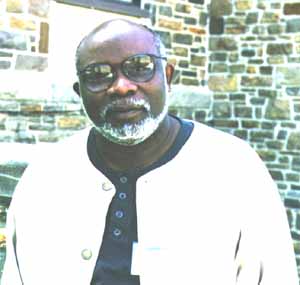![]()
Tepper L. Gill

Born: February 13, 1941; Birthplace: Selma, Alabama (raised in Detroit, Michigan)
BS (1966) Wayne State University; M.S. (1969) Wayne State University
Ph.D. (1974) Mathematics, Wayne State University
thesis: Tensor Products of Contraction Semigroups in Hilbert Spaces; Advisor: A. T. Bharucha-ReidArea of Research Interests: Mathematical Physics
Professor of Mathematcs, Howard University
personal or universal URL: none
email: tgill@howard.eduTepper Gill earned all three of his degrees from Wayne State University- his B.S. in mathematics and physics (1966), his M.S. (1969) and his Ph.D. in Applied Mathematics (1974). His Ph.D. advisor was also an African American, A. T. Bharucha-Reid.
At Howard University, starting as an Assistant Professor in 1976, Dr. Gill was promoted to Associate Professor in 1981, and Professor in 1988. In 1987 he became the Chairman of the Department of Electrical Engineering. He has a joint appointment in the Departments of Electrical Engineering and Mathematics. He is also a Professor for the Division of Theoretical Physics at the Instituto per la Ricerca de Base in Italy. He is an editor of the HADRONIC JOURNAL, a periodical with a primary focus in theoretical and mathematical physics.
A Brief Biography
For Gill, the passion for mathematics would take a circuitous route--one marked with an early waning interest in academics. Outside of School, Gill showed promise as a gifted and talented singer and musician. One source of that encouragement and inspiration had been his ninth grade music teacher, George Shirley who subsequently became a singer with the Metropolitan Opera.
Gill's music career might have taking him further had it not been for his dormant academic prowess. Teachers wanted to nominate him for a scholarship in voice, but because his academic record was lackluster, he lost the opportunity. When an opportunity came along to work on a race track, Gill, along with his brother Gus, took it, and left Detroit to take care of horses. Money was scarce, they were young, discrimination was rampant, horse racing towns were often in areas of official racism. Thus, the Gill brothers returned to Detroit, enrolled in night school and began preparing for entrance into college. While Gill studied mathematics, his brother Gus went on to become a medical doctor, after gradating from the Michigan School of Medicine.
Two characteristics of the field of mathematics sparked Gill's budding analytical passions: the sincerity of the professors who encouraged him to persevere and the objectivity with which the assessment of abilities played out in the classroom. For Gill, mathematics became a place where he could both be himself as an African American and where the young men could uncompromisingly mature intellectually.
Graduate students and faculty members along the way had impressed him with the level of passion that they felt for mathematics; it was not unlike what he had felt for music. The outside world also had an impact on Gill's new found love. The Russian Space Satellite, Sputnik had been launched in 1957 and America catapulted into the space race offering talented students, scholarships and opportunities to gain experience and advanced degrees.
Gill's reputation as an up-and-coming leader did not go unnoticed. Prior to completing his dissertation, he was recruited to lead the city of Detroit's Economic Development Corporation (EDC). As Vice President for Planning and Development (1971-1974), he put his sharpened analytical abilities to work on developing opportunities for entrepreneurs and minority businesses committed to helping the city revamp its economic potential. After completing his doctorate and just before joining the faculty of Howard University, he helped start the Organization for Applied Science in Society and served as Vice President for (1974-1976). This was a private non-profit company devoted to the use of operations research and information systems technology in improving public services. He lead a major effort to modernize public housing management throughout the midwest.
Gill's commitment to the community and his love of mathematical research would be a themes throughout his career. Even as he accepted an offer to become an Assistant Professor at Howard University, in Washington, DC, in 1976, he continued to explore ways to expand economic options and opportunities for minorities in science and in the community. At Howard, he used his considerable background to found and direct the Howard University Computational Science and Engineering Research Center (1990-1996). Gill brought the first Super computer to Howard University, through his partnership with the University of Minnesota and the Army High Performance Computing Research Center. For the period of time that Gill directed the center, he brought into the University over $100 million in research grants and contracts, which provided financial support for over 40 faculty members. senior research scientists and young Ph.D. research fellows. In addition, nearly a hundred graduate and undergraduate students were trained and supported by the center.
Still a lover of music, Gill confines his singing to the church.
RESEARCH NOTES
Dr. Gill has 27 publications in mathematics and mathematical physics. (See Selected Publications below) Well-respected in the academic community because of his research, Gill has been a Visiting Professor and Chancellor research fellow in Mathematics at the University of California, Berkeley (1981-1982). He has been a research Fellow at the High Energy Astrophysics Laboratory, Goddard Space Flight Center, Greeenbelt, Maryland (1977-1980), Fermi National Accelerator laboratory, Batavia, Illinois (1982) and the Naval Research Laboratory in Washington, DC (1983-1985). In 1997, Gill was a Member in the School of Mathematics of the Institute for Advanced Studies, Princeton, New Jersey, where he investigated a new implementation of the special theory of relativity which does not require the use of time as a fourth coordinate. His current research interests included relativistic quantum mechanics, classical electrodynamics, non linearly dynamical systems and probability theory.
references:
SUMMA Gill web page: http://www.maa.org/summa/archive/Gill_T.htm
![]()
The web pages
MATHEMATICIANS OF THE AFRICAN DIASPORA
are brought to you by
The Mathematics Department of
The State University of New York at Buffalo.
They are created and maintained
by
Scott W. Williams
Professor of Mathematics